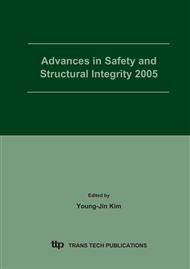p.163
p.169
p.177
p.183
p.193
p.201
p.213
p.221
p.231
Cleavage Fracture Evaluation Using Local Approach for SA508 Carbon Steel at -60°C
Abstract:
The scatter of measured fracture toughness data and transferability problems for specimens with different crack configurations and loading conditions are major obstacles for integrity assessment of ferritic steels in ductile-brittle transition region. To address these issues, recently, concerns for local approach adopting micro-mechanical damage models are being increased again in connection with a progress of computational technology. In this paper, cleavage fracture evaluation based on Weibull statistics was carried out for SA508 carbon steel. A series of three dimensional finite element analyses as well as corresponding fracture toughness tests were performed for 1T-CT and PCVN specimens at -60°C. Also, failure probability analyses for different configurations and sensitivity analyses for Weibull parameters were conducted. Thereby, promising results have been derived through comparison between measured and estimated fracture toughness data, which can be utilized to make the basis for demonstrating real safety margins of components containing defect.
Info:
Periodical:
Pages:
193-200
Citation:
Online since:
March 2006
Authors:
Price:
Сopyright:
© 2006 Trans Tech Publications Ltd. All Rights Reserved
Share:
Citation:


